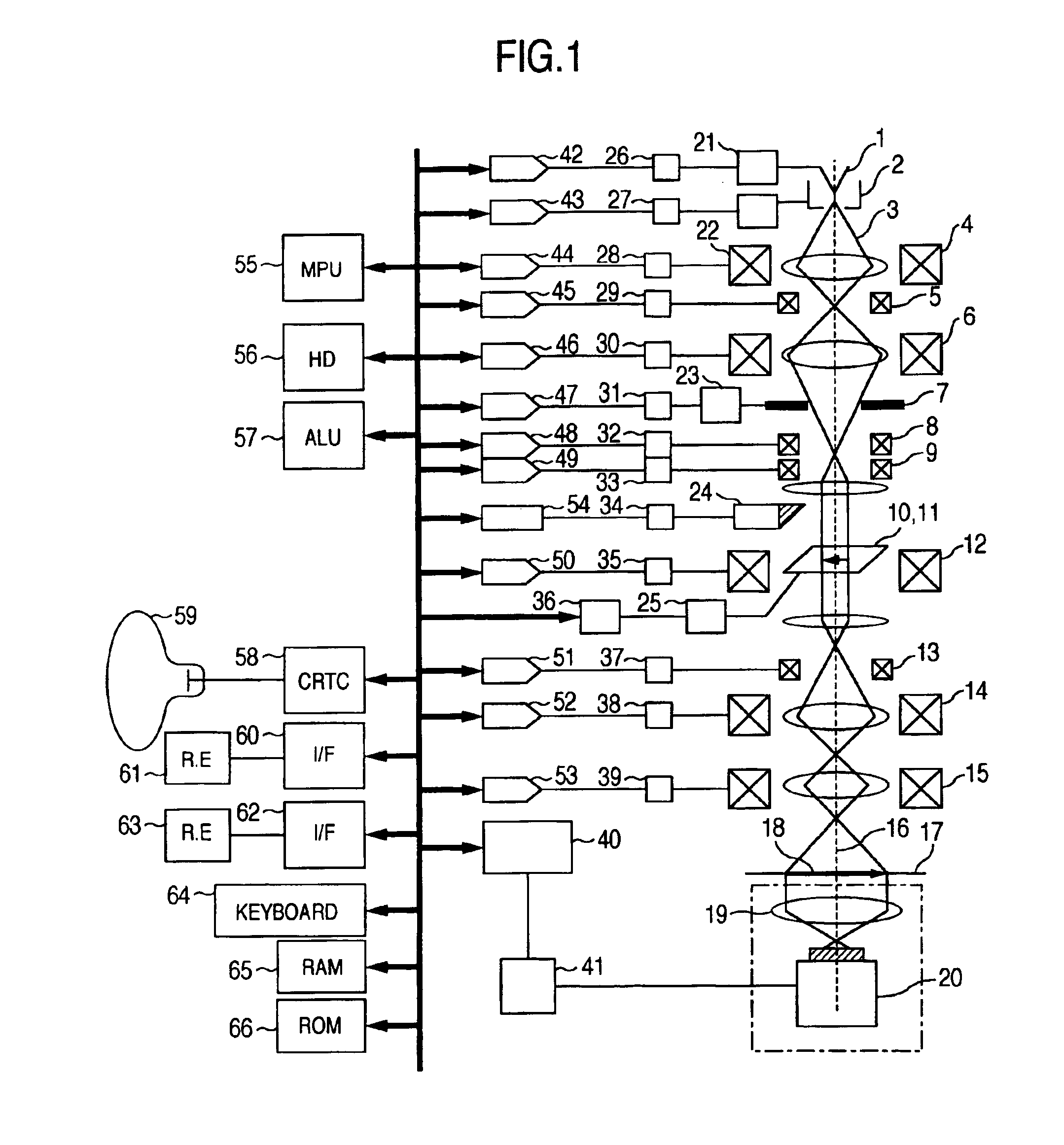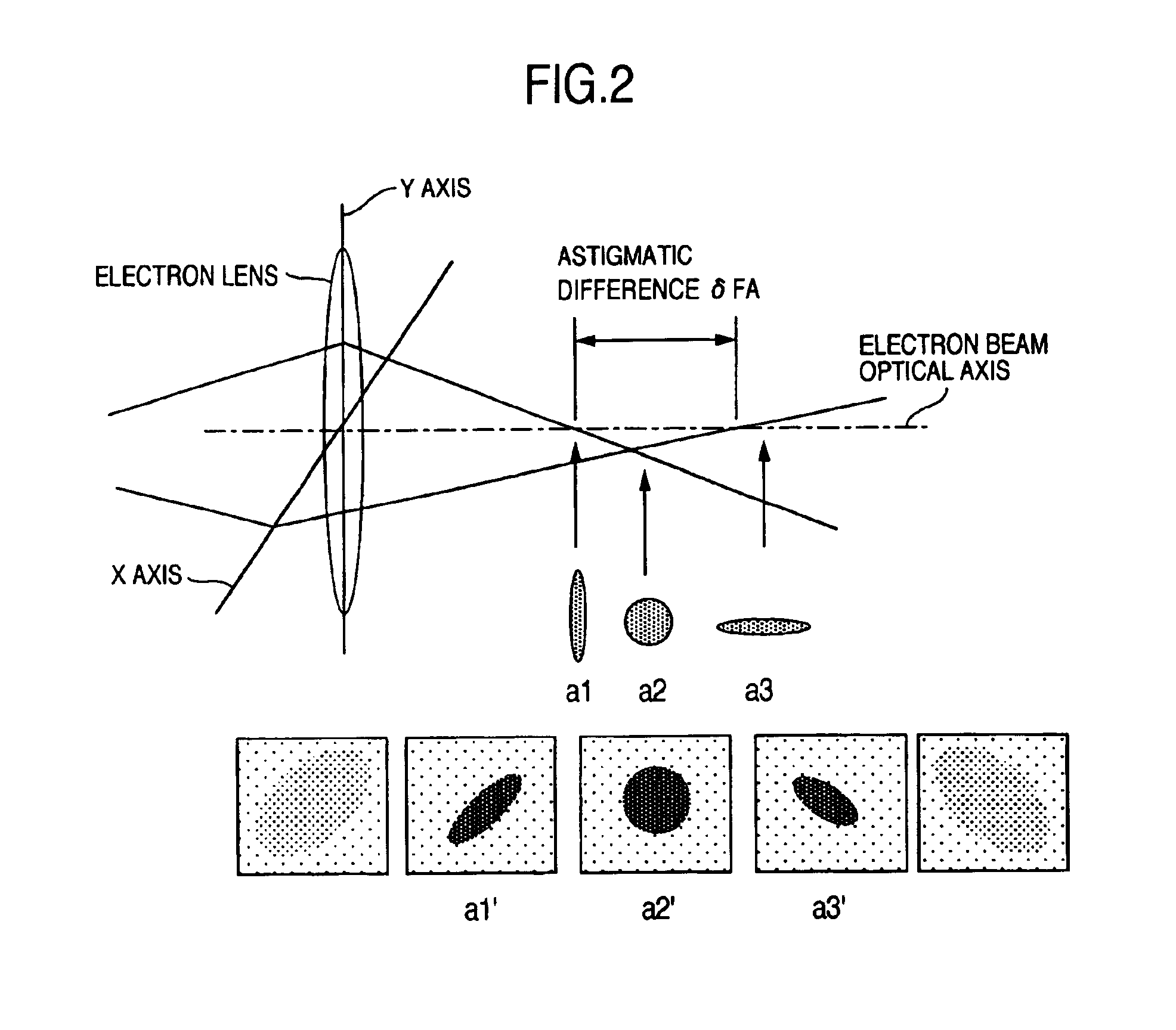Electron microscope
a technology of electron microscope and microscope, which is applied in the direction of instruments, material analysis using wave/particle radiation, nuclear engineering, etc., can solve the problems of low image contrast of enlarged specimen images, difficulty in discriminating astigmatism correction directions, and low image contrast of images, so as to improve the operation capability of electron microscope and high reproducibility
- Summary
- Abstract
- Description
- Claims
- Application Information
AI Technical Summary
Benefits of technology
Problems solved by technology
Method used
Image
Examples
first embodiment
[0096]By making reference to a flowchart in FIG. 6, the present invention will be described. In the present embodiment, the electron microscope shown in FIG. 1 is used to decide whether the focus of an enlarged specimen image is defocused and at the same time whether astigmatism exists and to perform automatic correction, thereby solving the first problem.
[0097]In step S101, the use of the electron microscope is started. A desired specimen 11 is mounted to the specimen stage 10 and is then inserted to the electron microscope. In step 102, a desired magnification is set by means of the magnification switching rotary encoder 61 shown in FIG. 1. Concurrently, data of electron beam source precedently recorded in the ROM 66 is called out and processed by the microprocessor 55 so that a current may be delivered out of a DAC 42 and a stabilizer 26. This current is supplied to the emitter 1 via a cathode power supply 21 and electrons are emitted from the emitter 1. As for acceleration volta...
second embodiment
[0107]Referring now to a flowchart in FIG. 11, this invention will be described. The present embodiment makes a decision as to whether the focus of an enlarged specimen image is defocused and as to whether an astigmatic aberration exists so as to perform automatic correction, thereby solving the first problem. The flowchart in FIG. 11 shows algorithm capable of determining an image sharpness coefficient dependent on angular directions with a view to simplifying algorithm and speeding up operation.
[0108]In step 201, the use of the electron microscope is started. A desired specimen 11 is mounted to the specimen stage 10 and is then inserted to the electron microscope. In step S202, setting of observation magnification, respective lens coil currents, respective deflection coil currents, focus correction parameters and astigmatism correction parameters is carried out. Step S202 corresponds to the step S102 explained in connection with FIG. 7.
[0109]In step S203, the focus is changed. Thi...
third embodiment
[0119]Referring now to a flowchart in FIG. 12, this invention will be described. In this embodiment, a pixel mean value of an image is determined to capture a change in image contrast during astigmatism correction, so that under a condition that a large astigmatic aberration exists and an enlarged specimen image becomes blurred seriously, the astigmatism correction can be effected, thereby solving the second problem. The FIG. 12 flowchart is inserted between the steps S102 and S103 in FIG. 6 or between the steps S202 and S203 in the FIG. 11 flowchart in order to make the focus and the astigmatism of the enlarged specimen image substantially coincident to each other.
[0120]After the initial setting in the step S102 in FIG. 6 or the initial setting in the step S202 in FIG. 11 has been completed, the program proceeds to step S301 in FIG. 12. In the step S301, the focal position in the electron microscope is changed and image sharpness coefficients are calculated in step S302. In the pre...
PUM
| Property | Measurement | Unit |
|---|---|---|
| electron microscope | aaaaa | aaaaa |
| current | aaaaa | aaaaa |
| threshold | aaaaa | aaaaa |
Abstract
Description
Claims
Application Information
 Login to View More
Login to View More - R&D
- Intellectual Property
- Life Sciences
- Materials
- Tech Scout
- Unparalleled Data Quality
- Higher Quality Content
- 60% Fewer Hallucinations
Browse by: Latest US Patents, China's latest patents, Technical Efficacy Thesaurus, Application Domain, Technology Topic, Popular Technical Reports.
© 2025 PatSnap. All rights reserved.Legal|Privacy policy|Modern Slavery Act Transparency Statement|Sitemap|About US| Contact US: help@patsnap.com



